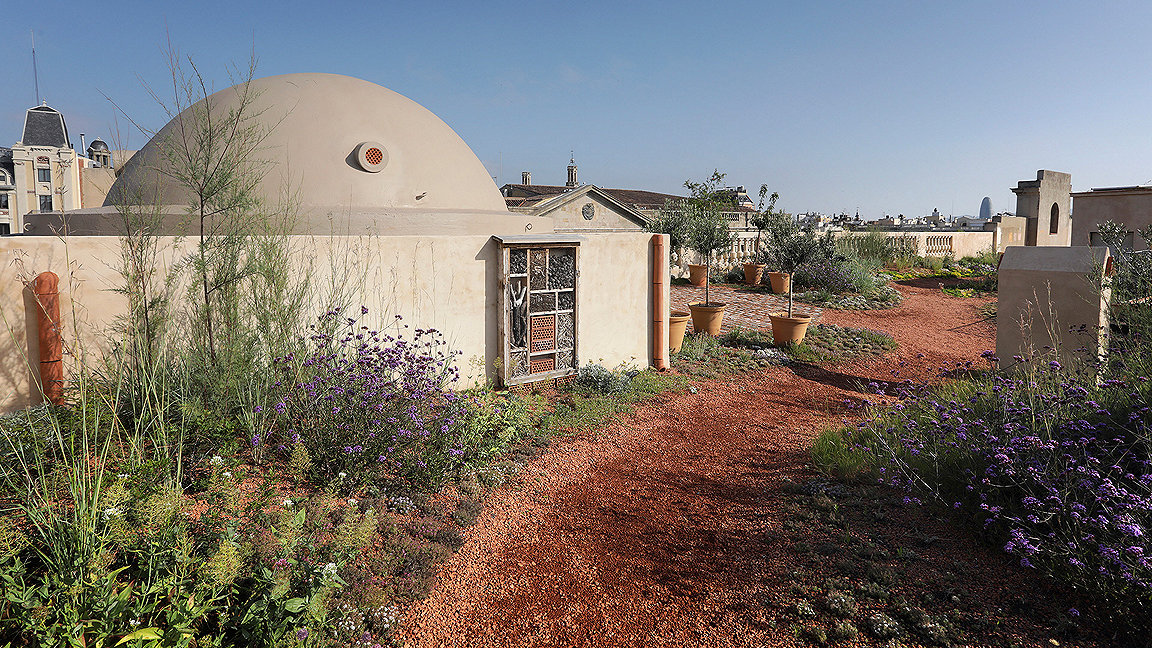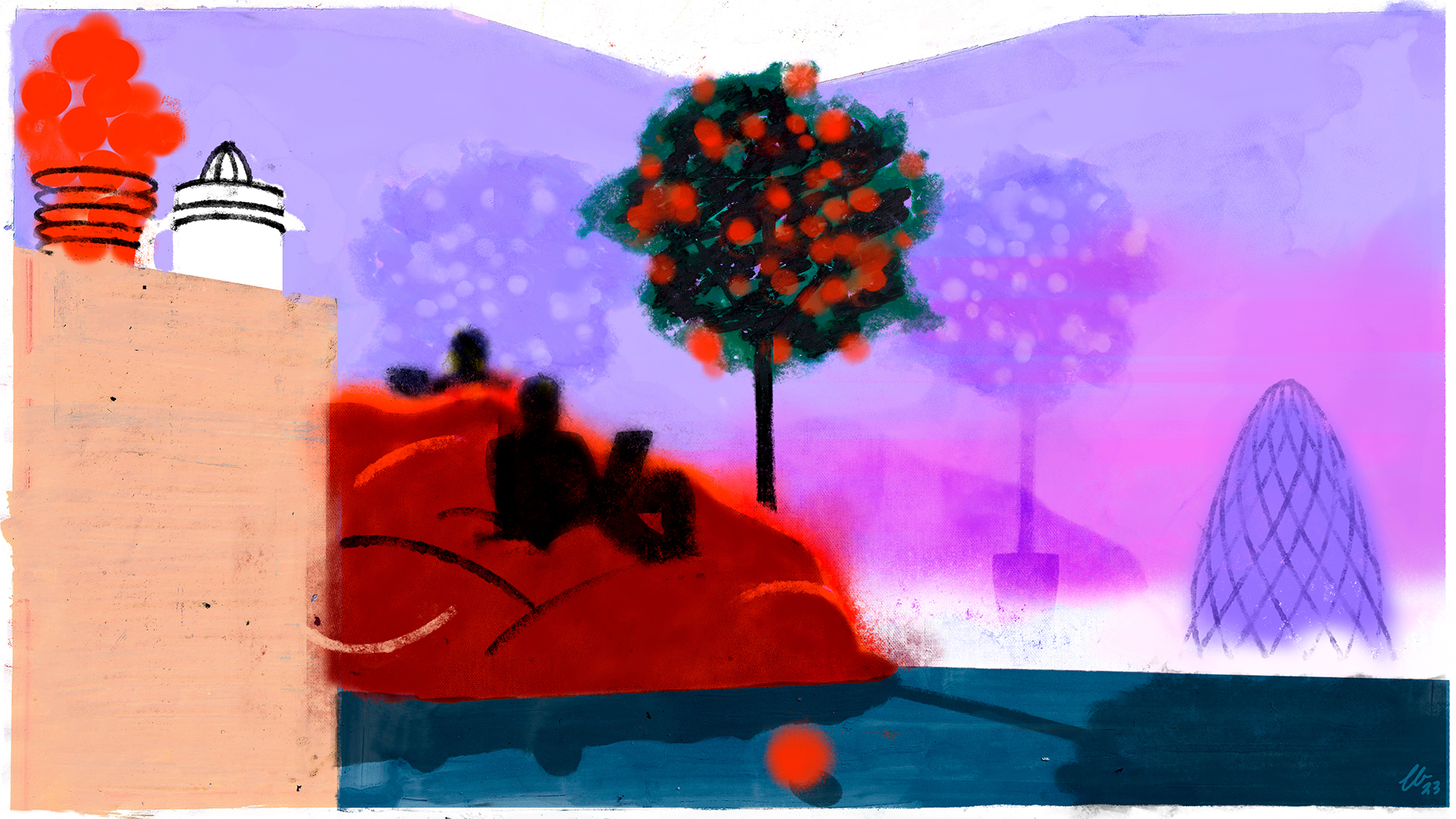
Xifré’s Rooftop: “Floating” Wild Garden. Photo courtesy of the European Union
On a park site just east of the city centre in Kortrijk, Belgium, lies De Korenbloem, a leafy, open care campus offering residential and day care for younger people suffering from early-onset dementia.
Here, small groups of residents live in a comfortable home-like environment architecturally designed to help soothe their condition as part of a radical, compassionate and integrated care project. De Korenbloem is notable not just for its inclusive care, but also for its sustainability and how it emotionally connects people with places – the very elements that are emblematic of the New European Bauhaus.
Launched in 2021, the New European Bauhaus (NEB) is an ambitious EU initiative to help drive the societal transformation needed to reach net zero carbon emissions by 2050. It is designed to breathe cultural life into the European Green Deal, its huge legislative and regulatory framework for a net zero future.
It draws inspiration from the original German Bauhaus movement of the early 20th century which married design, architecture and the arts into one discipline. With its core values of sustainability, aesthetics and inclusion it is hoped the NEB will become a philosophy that guides the reimagining of sustainable living in Europe. “If the European Green Deal has a soul, then it’s the New European Bauhaus,” the EU president Ursula von der Leyen once said.
A collaborative network
The NEB is backed by €100m of EU funding so far and has multiple strands from six ‘demonstrator’ projects across 14 countries, an NEB Lab to promote education and research, and the annual NEB Prizes. A fundamental part of New European Bauhaus is collaboration, building on the heritage on the original Bauhaus to bring together different professionals working towards sustainability in every aspect of life. The NEB already has 600 partner organisations, ranging from the built environment to universities, fashion and engineering institutions, culture heritage and crafts bodies, to construction and health.
“If I was to define the New European Bauhaus, I would say it really is a collaborative network,” says Valeria Sepe, sustainability specialist at RICS. The Institution joined the New European Bauhaus as a partner in January this year and Sepe says its three main elements: sustainability, aesthetics and inclusion were “a good match” with its IBOS standard.
“It doesn’t only focus on aesthetics,” Sepe explains, “but also on functionality. It also speaks about inclusion, the social dimension of buildings that’s sometimes forgotten about – what people can afford.” She points to the Actions for Ukraine project as a prime example of the New European Bauhaus’s focus on collaboration. Here the NEB community has launched a capacity-building programme to help prepare Ukrainian local authorities to restore and rebuild their cities post-war in sustainable and inclusive ways. It also links up European industry experts with those in the country.
In the built environment, proponents of the New European Bauhaus see it as a way of connecting parts of the industry, such as investment, legislation and technical, with environmental and socially sustainable aspects. And then translating them for everyone into a more tangible vision. “For me it’s really important because it translates things into elements that people, businesses, companies and city leaders can understand,” says Xavier Denis MRICS, chief development officer at Brussels-based AG Real Estate. “Having a New European Bauhaus which is here to link the technical side, the legislative side, with the population at large is quite exciting.”
AG Real Estate manages a €7bn property portfolio with 1.5million m2 under development. Denis says sustainability and ESG are at the forefront of its business model and when the NEB was launched, he saw it as “something that we can understand, and a good way to explain what we do and the impact that our business has on cities and people.”
UN Sustainable Development Goals
He points to its project in Brussels, the CCN building at the Gare du Nord, as an example of how the NEB can be translated into the sector. The 160,000m2, mixed-used development is on one of Brussels’s main train stations and is also a mobility hub for other public transport. It’s currently in planning consent and has been designed to adhere to the UN’s Sustainable Development Goal 11, creating sustainable cities and communities. It will reuse existing building materials and will be a test bed for geothermal energy.
The North Station area is currently run down and viewed as precarious by many in the local community, so much of the design is about opening up the public area around the station to make it more accessible and inclusive. Denis adds that a key part of its inclusivity has been consulting and including all the local stakeholders right from the initial “architectural competition and definition of the brief”.
“When you do all of that with a multidisciplinary approach, everything comes to life in terms of the debates you can have.” And he says much was changed as a result: the housing component; the layout of its retail units; the skyline of the building; placement of public benches; and the way it will be lit at night. He adds that improving the public space and the architecture should significantly boost the aesthetic appeal of the area.
Denis concedes that among his peers the NEB isn’t yet widely known. “I think the New European Bauhaus can have a strong impact,” he says. “At the end of the day the value of real estate is the value that people perceive and whether they view your building as having a positive impact on their life. We should structure the way we do business in a way that makes sense for people and for the sustainability agenda and there is still a way to go.”
To give the industry more guidance the EU is currently refining tools to enable it to measure projects against NEB principles. Its labelling strategy includes the NEB Compass and self-assessment tools, which are due to launch by summer 2024.
“If the European Green Deal has a soul, then it’s the New European Bauhaus” Ursula von der Leyen, EU president
Retrofitting sustainability
Back in Belgium and De Korenbloem, with its retrofitted historical villas linked to two new build blocks, cutting-edge sustainable technology and an inclusive care model, was awarded an NEB Prize last year. Mark Tuff, managing partner at Sergison Bates, the project’s architect, says right from the beginning De Korenbloem was unique. He says it was part of a pilot project to develop “invisible care” for the region and unusually stakeholders were all bought together in one room to make decisions. “This meant we could have a dialogue to adapt the rules to support the project,” he says.
The design of De Korenbloem also draws heavily on the latest research on how dementia patients react with their spatial surroundings. “What we needed to do was have a series of small worlds. It helped shaped the idea that the shared communal space was not one but three interconnected spaces. They can feel a kind of comfort in a small space, but know there’s one beyond it.”
De Korenbloem was among 18 winners, including a project to restore heritage buildings in Poland, a digital mapping tool and a sustainable co-housing development in Vienna, Austria. Significantly, the winners and runners up all shared cash prizes of up to €30,000 as part of the EU’s campaign to inspire more NEB-style projects. Tuff says the cash will be used to evaluate the four care projects it has completed in the last 16 years. “Thinking around care has developed over time,” he says. “It’s really valuable to go back and look at those projects and learn from them. In a way that’s the most tangible consequence of the New European Bauhaus for us.”
Tuff adds that he hopes that the New European Bauhaus “shines a light” on different ways of providing care inside communities. “That it allows people to say ‘okay it can be done, it can be connected to the community,’ because it’s been recognised by the European Commission and that gives it a certain kind of legitimacy.”
“It doesn’t only focus on aesthetics, but also on functionality” Valeria Sepe, sustainability specialist at RICS
New European Bauhaus demonstrator projects include:
-
Cultuurcampus (Netherlands)
By creating a hub of education, research, policy and culture, Cultuurcampus aims to transform the disadvantaged area of Rotterdam South.
-
NEBourhoods (Germany)
Preparing Munich-Neuperlach for the future under the European Green Deal – this project will look at the built environment, circularity, mobility, energy food and health.
-
Desire – designing the irresistible circular society
This project looks at the challenges of climate change, biodiversity loss and dwindling resources across five European cities, and looks at how art, architecture and design can come up with alternative solutions to transform these territories.

